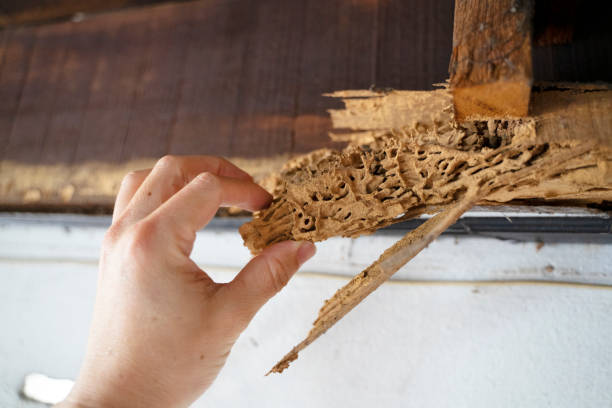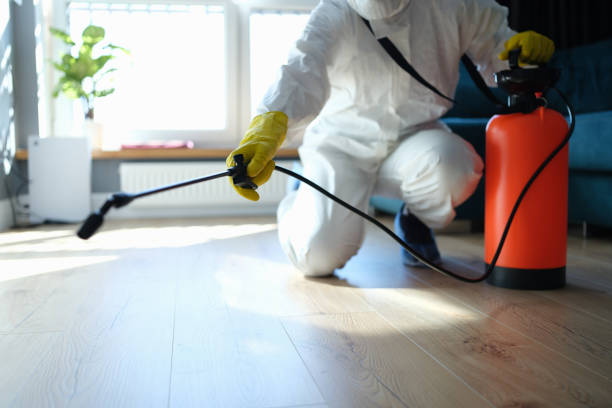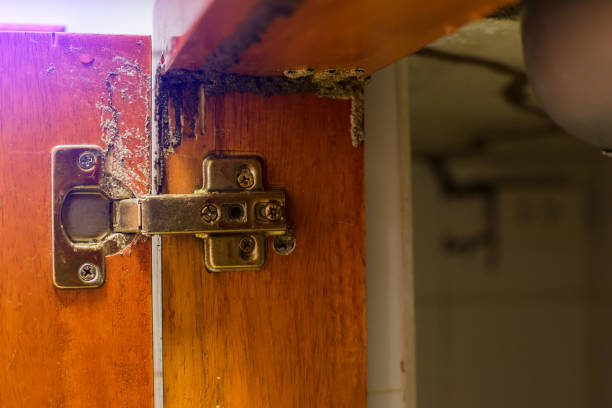
Termites, often referred to as “silent invaders,” are small insects capable of causing significant damage to homes and properties. Despite their size, the impact they have on structures can be devastating if left unchecked. To protect your property effectively, it is essential to understand how termites operate, the extent of their damage, and their economic impact.
Understanding Termites: A Guide to Miami Pest Control
Termites are social insects that belong to the order Isoptera. They feed primarily on cellulose, a key structural component found in wood, paper, and other organic materials.
- Subterranean Termites: These termites build colonies underground and rely on soil moisture for survival. They are the most destructive species.
- Drywood Termites: Found within wooden structures or furniture, they require no contact with soil.
- Dampwood Termites: Preferring damp or decaying wood, these termites thrive in high-moisture environments.
Each type has unique behaviors but shares a relentless drive to consume cellulose-based materials.
How a Termite Control Company in Miami Can Help Prevent Costly Infestations
The financial losses associated with termite infestations are staggering. Global estimates indicate billions of dollars spent annually on termite damage repairs and prevention measures.
| Statistic | Value |
| Annual property damage | Over $5 billion |
| Cost per homeowner | $3,000 (on average) |
| Insurance coverage | Rarely included in plans |
Unlike natural disasters such as floods or fires that leave visible signs of destruction immediately after occurring, termite damage progresses slowly but steadily over time. This often leads to delayed detection and higher repair costs.
Effective Solutions from a Termite Exterminator Miami Residents Trust
Termite activity typically begins unnoticed due to their ability to hide within walls or underground tunnels.
- Weakened Wooden Structures: Termites hollow out beams and posts from within.
- Compromised Foundations: Subterranean termites use mud tubes to travel between soil and wood.
- Harmed Insulation Systems: Cellulose-based insulation becomes an easy target.
- Damage Beyond Wood: Termites can also chew through electrical wiring or plastics in search of food.
Left unattended, termite infestations can lead to sagging floors or ceilings, cracked walls, stuck windows/doors due to warping wood, and even complete structural failure in extreme cases.
The Importance of Timely Termite Removal Miami Residents Should Know
Detecting termites early is critical for minimizing long-term harm. Since these pests often work silently behind walls or beneath floors without immediate visible signs, homeowners must remain vigilant year-round. Investing in professional inspections at least once annually can provide peace of mind while safeguarding your most valuable asset—your home.
| Timeframe | Approximate Colony Size |
| 6 months | A few thousand termites |
| 1 year | Upwards of 50k members |
| Mature colony (several years) | Hundreds of thousands |
By recognizing their habits and potential for destruction early on through education like this guide exemplifies many costly outcomes may be avoided altogether
Physical Signs of Termite Activity
- Winged termites emerging indoors or near your property are often the first visible sign of an infestation.
- Cracked or blistered paint on wooden surfaces could also indicate hidden termite activity.
- Drywood termites often leave behind small piles of wood-colored pellets resembling sawdust near affected areas.
- Look for frass around baseboards, window frames, or wooden furniture.
- If floors feel spongy underfoot or ceilings appear warped, this could indicate significant termite damage within structural elements like joists and beams.
Behavioral Indicators of an Infestation
- Unusual Sounds: Soldier termites may bang their heads against tunnel walls to alert other colony members when disturbed, producing faint clicking sounds.
- Increased Pest Activity: Ants might be drawn to discarded termite wings left after swarming events, signaling potential termite presence nearby.
Areas Prone to Infestation
| Area | Why It’s Vulnerable |
| Foundation | Direct contact with soil allows easy access for subterranean termites. |
| Crawl Spaces | High moisture levels create ideal conditions for colonies. |
| Wooden Decks & Fences | Exposed wood offers easy food sources for drywood termites. |
| Attics | Poor ventilation can lead to condensation and attract pests seeking moisture sources. |
What To Do If You Suspect an Infestation
- Contact a licensed pest control professional immediately for a thorough inspection.
- Avoid disturbing suspected colonies; this can cause termites to scatter and establish new infestation points.
- Keep track of all observed evidence (e. g. , photos of mud tubes or swarmers) as documentation for evaluation by experts.
Exploring Effective Termite Control Methods: Chemical Treatments and Bait Systems
Termites are among the most destructive pests that can invade your home, causing significant structural damage and financial loss. To effectively combat these silent invaders, it is essential to understand modern termite control methods, including chemical treatments and bait systems. This section delves into these techniques and how they work to protect your property.
Chemical Treatments: A Proven Line of Defense
Chemical treatments, also known as termiticides, are widely used for both preventive and corrective termite control measures. They act as a barrier between termites and your home’s structure by either repelling or eradicating the pests upon contact.
Types of Chemical Treatments: – Liquid Soil Treatments: Applied directly to the soil around a property’s foundation, these create a continuous chemical barrier that termites cannot cross.Wood Treatments: Surface sprays or injections infused with termiticides are applied directly to exposed wood to protect it from termite attack.Foam Applications: Ideal for hard-to-reach areas such as wall voids or crawl spaces, foam products expand into cracks and kill termites on contact.
Advantages of Chemical Treatments: – Long-lasting protection (some products remain effective for up to 10 years). – Immediate results in eliminating active infestations. – Suitable for pre-construction as well as post-construction use.
| Treatment Type | Best For | Duration of Effectiveness |
| Liquid Soil Treatments | Large-scale ground infestations | Up to 10 years |
| Wood Treatments | Exposed wooden fixtures | 3–5 years |
| Foam Applications | Hard-to-access areas | Varies (depends on usage) |
Bait Systems: Targeted Termite Elimination
Bait systems provide an environmentally friendly alternative to chemical treatments by using strategically placed bait stations that attract termites. These stations contain slow-acting insecticides disguised as food sources. As termites consume the bait and share it within their colony, the population is gradually eradicated.
Steps in Implementing Bait Systems: 1.Installation of Bait Stations: Placed around the perimeter of the home at regular intervals. 2.Monitoring Stations Regularly: Inspections ensure that termites are actively feeding on the bait. 3.Replacing Consumed Baits with Active Ingredients: When termite activity is detected, baits containing slow-acting toxicants are introduced.
Benefits of Bait Systems: – Environmentally safe since they minimize pesticide use. – Highly targeted approach that specifically affects termite colonies without harming other insects or animals. – Easy installation with minimal disruption to daily life.
Comparing Chemical Treatments vs.
| Feature | Chemical Treatments | Bait Systems |
| Speed | Immediate action | Gradual but thorough |
| Environmental Impact | May use significant chemicals | Minimal pesticide application |
| Maintenance Requirements | Low | Requires consistent monitoring |
By combining both approaches when necessary, homeowners can achieve comprehensive protection against termites while addressing specific infestation challenges effectively.
Choosing The Right Solution for Your Home
The choice between chemical treatments and bait systems depends on several factors such as location, extent of infestation, environmental considerations, and budget constraints. Consulting a licensed pest control professional ensures an accurate assessment of your property’s needs while offering tailored solutions for optimal termite management.
Exploring Effective Termite Control Methods: Chemical Treatments and Bait Systems
Effective termite control is critical to protecting your home from the extensive damage these pests can cause. Two of the most widely used and efficient methods for managing termite infestations are chemical treatments and bait systems. Understanding how these methods work will help you make informed decisions about safeguarding your property.
Chemical Treatments for Termite Control
Chemical treatments, also known as liquid termiticides, create a barrier around your property to kill and repel termites. These treatments are often applied by professional pest control experts and are designed to last for several years with proper maintenance.
Types of Chemical Treatments: – Repellent Termiticides:Create a chemical barrier around the structure that deters termites from entering.Non-Repellent Termiticides:These allow termites to pass through the treated zone, unknowingly ingesting or contacting the toxin, which is then spread throughout their colony.
Benefits:– Provides immediate protection against termites. – Long-lasting effects when applied correctly. – Targets both subterranean and drywood termites.
Considerations:– Requires professional application for optimal results. – Potential environmental concerns if not applied carefully.
Bait Systems for Targeted Control
Bait systems provide a more targeted approach by attracting termites to a specially designed station where they consume a slow-acting toxic bait. Over time, this poison spreads throughout the colony, leading to its eventual collapse.
How Bait Systems Work:1. Stations are strategically placed in areas where termite activity is detected or likely (e. g. , near wood piles or moist soil). 2. Termites feed on the bait and carry it back to their colony. 3. The slow action of the bait ensures that it affects many members of the colony, including reproductive individuals like queens.
Benefits:– Minimal disruption to your property compared to chemical treatments. – Eco-friendly options are available with reduced risk to non-target species. – Effective at eliminating entire colonies over time.
Considerations:– May take longer than chemical treatments to show visible results. – Requires ongoing monitoring and maintenance of stations.
| Aspect | Chemical Treatments | Bait Systems |
| Speed of Action | Immediate protection | Gradual elimination |
| Effectiveness | High with proper application | High when monitored properly |
| Cost | Higher upfront cost | Relatively lower initial cost |
| Environmental Impact | Potentially higher | Lower due to targeted approach |
Choosing the Right Method
The choice between chemical treatments and bait systems depends on several factors: 1.Severity of Infestation:Severe infestations may require immediate action through chemical barriers. 2.Property Environment:Homes in areas prone to moisture may benefit from strategic monthly monitoring with bait systems. 3.Budget:While chemical methods have higher upfront costs, they offer long-term protection; bait systems may require consistent investment over time.
For comprehensive protection against termites, homeowners often combine both methods as part of an Integrated Pest Management (IPM) strategy. Collaborating with licensed pest control professionals ensures that these solutions are implemented effectively while minimizing risks associated with misuse or overapplication.
How to Prevent Termite Infestations Through Moisture Control and Wood Management
Preventing termites from invading your home begins with strategic steps to eliminate their primary attractants: moisture and wood. These two factors are essential for termites’ survival and can significantly contribute to infestations if not managed properly. Below are actionable measures homeowners can take to protect their property.
Importance of Moisture Control
Termites thrive in environments where moisture is readily available. Excessive dampness, whether indoors or outdoors, creates an ideal habitat for termite colonies.
- Repair Leaks: Check pipes, faucets, and air conditioning units for leaks. Even small drips can create a water source for termites.
- Maintain Proper Drainage: Ensure that rainwater drains away from your home’s foundation by installing functional gutters and downspouts.
- Use a Dehumidifier: In humid climates, controlling indoor humidity levels with a dehumidifier can reduce the likelihood of attracting termites.
- Ventilate Crawl Spaces: Poorly ventilated crawl spaces trap moisture. Consider installing vents or fans to improve airflow underneath your home.
Effective Wood Management Techniques
Wood is a primary food source for termites.
- Store Firewood Away from Your Home: Keep stacks of firewood at least 20 feet away from your house and elevate them off the ground.
- Use Treated Wood: For outdoor structures like decks and fences, use pressure-treated wood that is resistant to termite damage.
- Remove Dead Trees and Stumps: Decaying wood in your yard serves as an entry point for termites. Eliminate rotten stumps, tree roots, or other debris.
- Avoid Direct Soil Contact with Wood: Ensure that wooden elements of your home (e. g. , siding or support beams) do not touch the soil directly.
Combining Moisture Control with Regular Maintenance
Preventing termite infestations requires consistent attention and maintenance beyond just moisture control and wood management.
| Area of Focus | Action Steps |
| Landscaping Practices | Trim vegetation near the home’s exterior; avoid mulch piles close to foundations. |
| Foundation Inspections | Seal cracks or gaps around utility lines entering your home. |
| Roofing Maintenance | Repair damaged shingles or flashing to prevent water seepage into walls or ceilings. |
Long-Term Benefits
Taking proactive steps through moisture control and wood management not only wards off termite infestations but also contributes to the overall health of your property by reducing risks associated with mold growth, structural decay, and pest invasions.
By integrating these practices into your routine home maintenance plan, you create an environment less conducive to termites while safeguarding one of your most valuable investments—your home.
The Importance of Regular Inspections to Detect and Prevent Termite Damage
Regular inspections play a pivotal role in safeguarding your home from termite infestations. These silent destroyers can cause significant damage to the structural integrity of your property if left undetected. By scheduling routine inspections, homeowners can identify early signs of termite activity, mitigate potential risks, and save on costly repairs.
Benefits of Regular Termite Inspections
- Identifies active termites before they cause extensive damage.
- Uncovers subtle signs like mud tubes, wood damage, or discarded wings.
- Reduces expenses associated with repairing structural damage.
- Prevents the need for more aggressive (and expensive) treatments.
- Assurance that your property is protected from potential infestations.
- Allows for proactive maintenance rather than reactive solutions.
- Maintains the market value of your home by preventing termite-related deterioration.
- Provides documentation for prospective buyers during property sales.
Key Areas to Inspect for Termites
During an inspection, certain areas are more prone to termite activity than others.
| Area | Why It’s Important |
| Foundation and Basement | Termites often enter homes through cracks in foundations or damp basements. |
| Wooden Structures | Beams, joists, and studs are prime targets due to their cellulose content. |
| Crawl Spaces | These areas provide dark, moist environments ideal for termites to thrive. |
| Exterior Walls | Cracks or gaps in walls near soil contact serve as entry points for termites. |
| Roof and Attic Spaces | Leaks or moisture issues here can attract drywood termites. |
Professional vs DIY Inspections
- Look out for mud tubes on walls or foundations.
- Tap wooden surfaces to detect hollow sounds.
- Check windowsills and light sources for discarded wings.
- Utilize moisture meters to identify damp areas conducive to termites.
- Employ infrared cameras to locate hidden colonies behind walls.
- Provide detailed reports with recommendations for prevention or treatment.
How Often Should You Inspect?
- Annually:Recommended as a standard practice in most regions.
- Biannually:Advisable in areas with high humidity or known termite prevalence.
- Post-Renovation:Conduct inspections after major renovations that involve woodwork or soil disturbance.
By incorporating regular inspections into your home maintenance routine, you can effectively detect potential threats early on and implement preventive measures promptly. A proactive approach ensures that termites don’t compromise the safety and structural integrity of your home over time.
- Effective Miami Termite Treatment: Recognizing the Signs of an Infestation in Your Home
- Effective Miami Termite Control: Protect Your Property from Damage
- The Ultimate Guide to Miami Termite Treatment and Identifying Infestations
- Miami Pest Control: A Comprehensive Guide to Protect Your Home from Termites
- Comprehensive Miami Termite Control Guide: How to Identify and Handle Termites
- Comprehensive Guide to Miami Pest Control and Understanding Termites
- Comprehensive Guide to Miami Termite Control: Protecting Your Property Effectively







